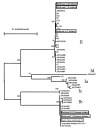Three drinking-water-associated cryptosporidiosis outbreaks, Northern Ireland
- PMID: 12023922
- PMCID: PMC2738494
- DOI: 10.3201/eid0806.010368
Three drinking-water-associated cryptosporidiosis outbreaks, Northern Ireland
Abstract
Three recent drinking-water-associated cryptosporidiosis outbreaks in Northern Ireland were investigated by using genotyping and subgenotyping tools. One Cryptosporidium parvum outbreak was caused by the bovine genotype, and two were caused by the human genotype. Subgenotyping analyses indicate that two predominant subgenotypes were associated with these outbreaks and had been circulating in the community.
Figures

References
-
- McLauchlin J, Amar C, Pedraza-Diaz S, Nichols GL. Molecular epidemiological analysis of Cryptosporidium spp. in the United Kingdom: results of genotyping Cryptosporidium spp. in 1,705 fecal samples from humans and 105 fecal samples from livestock animals. J Clin Microbiol. 2000;38:3984–90. - PMC - PubMed
-
- Sulaiman IM, Lal AA, Xiao L. A population genetic study of the Cryptosporidium parvum human genotype parasites. J Eukaryot Microbiol. 2001. In press. - PubMed
-
- Peng MM, Matos O, Gatei W, Das P, Stantic-Pavlinic M, Bern C, et al. A comparison of Cryptosporidium subgenotypes from several geographic regions. J Eukaryot Microbiol. 2001. In press. - PubMed
Publication types
MeSH terms
Substances
LinkOut - more resources
Full Text Sources
Medical
